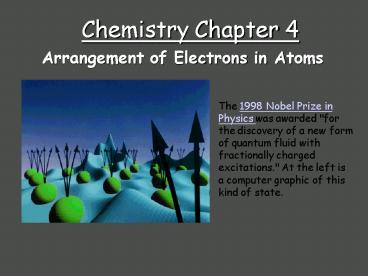Chemistry Chapter 4 PowerPoint PPT Presentation
1 / 33
Title: Chemistry Chapter 4
1
Chemistry Chapter 4
- Arrangement of Electrons in Atoms
The 1998 Nobel Prize in Physics was awarded "for
the discovery of a new form of quantum fluid with
fractionally charged excitations." At the left is
a computer graphic of this kind of state.
2
The Puzzle of the Atom
- Protons and electrons are attracted to each
other because of opposite charges - Electrically charged particles moving in a
curved path give off energy - Despite these facts, atoms dont collapse
3
Wave-Particle Duality
JJ Thomson won the Nobel prize for describing the
electron as a particle.
His son, George Thomson won the Nobel prize for
describing the wave-like nature of the electron.
The electron is a particle!
The electron is an energy wave!
4
Confused??? Youve Got Company!
No familiar conceptions can be woven around the
electron something unknown is doing we dont
know what.
Physicist Sir Arthur Eddington The Nature of the
Physical World 1934
5
The Wave-like Electron
The electron propagates through space as an
energy wave. To understand the atom, one must
understand the behavior of electromagnetic waves.
Louis deBroglie
6
Electromagnetic radiation propagates through
space as a wave moving at the speed of light.
c ??
C speed of light, a constant (3.00 x 108 m/s)
? frequency, in units of hertz (hz, sec-1)
? wavelength, in meters
7
Types of electromagnetic radiation
8
The energy (E ) of electromagnetic radiation is
directly proportional to the frequency (?) of the
radiation.
E h?
E Energy, in units of Joules (kgm2/s2)
h Plancks constant (6.626 x 10-34 Js)
? frequency, in units of hertz (hz, sec-1)
9
Wavelength Table
Long Wavelength Low Frequency Low ENERGY
Short Wavelength High Frequency High ENERGY
10
Spectroscopic analysis of the visible spectrum
produces all of the colors in a continuous
spectrum
11
Spectroscopic analysis of the hydrogen spectrum
produces a bright line spectrum
12
Electron transitionsinvolve jumps of definite
amounts ofenergy.
This produces bands of light with
definite wavelengths.
13
(No Transcript)
14
The Bohr Model of the Atom
I pictured electrons orbiting the nucleus much
like planets orbiting the sun.
But I was wrong! Theyre more like bees around a
hive.
WRONG!!!
Neils Bohr
15
Quantum Numbers
Each electron in an atom has a unique set of 4
quantum numbers which describe it.
- Principal quantum number
- Angular momentum quantum number
- Magnetic quantum number
- Spin quantum number
16
Pauli Exclusion Principle
No two electrons in an atom can have the same
four quantum numbers.
Wolfgang Pauli
17
Principal Quantum Number
Generally symbolized by n, it denotes the shell
(energy level) in which the electron is located.
Number of electrons that can fit in a shell
2n2
18
Angular Momentum Quantum Number
The angular momentum quantum number, generally
symbolized by l, denotes the orbital (subshell)
in which the electron is located.
19
Magnetic Quantum Number
The magnetic quantum number, generally symbolized
by m, denotes the orientation of the electrons
orbital with respect to the three axes in space.
20
Assigning the Numbers
- The three quantum numbers (n, l, and m) are
integers. - The principal quantum number (n) cannot be zero.
- n must be 1, 2, 3, etc.
- The angular momentum quantum number (l) can be
any integer between 0 and n - 1. - For n 3, l can be either 0, 1, or 2.
- The magnetic quantum number (m) can be any
integer between -l and l. - For l 2, m can be either -2, -1, 0, 1, or 2.
21
Principle, angular momentum, and magnetic quantum
numbers n, l, and ml
22
Spin Quantum Number
Spin quantum number denotes the behavior
(direction of spin) of an electron within a
magnetic field.
Possibilities for electron spin
23
An orbital is a region within an atom where
thereis a probability of finding an electron.
This is a probability diagram for the s orbital
in the first energy level
Orbital shapes are defined as the surface that
contains 90 of the total electron probability.
24
Schrodinger Wave Equation
Equation for probability of a single electron
being found along a single axis (x-axis)
Erwin Schrodinger
25
Heisenberg Uncertainty Principle
One cannot simultaneously determine both the
position and momentum of an electron.
You can find out where the electron is, but not
where it is going.
OR
You can find out where the electron is going, but
not where it is!
Werner Heisenberg
26
Sizes of s orbitals
Orbitals of the same shape (s, for instance) grow
larger as n increases
Nodes are regions of low probability within an
orbital.
27
s orbital shape
The s orbital has a spherical shape centered
around the origin of the three axes in space.
28
P orbital shape
There are three dumbbell-shaped p orbitals in
each energy level above n 1, each assigned to
its own axis (x, y and z) in space.
29
d orbital shapes
Things get a bit more complicated with the five d
orbitals that are found in the d sublevels
beginning with n 3. To remember the shapes,
think of double dumbells
and a dumbell with a donut!
30
Shape of f orbitals
31
Orbital filling table
32
Electron configuration of the elements of the
first three series
33
Irregular confirmations of Cr and Cu
Chromium steals a 4s electron to half fill its 3d
sublevel (extra stability)
Copper steals a 4s electron to FILL its 3d
sublevel (extra stability)

